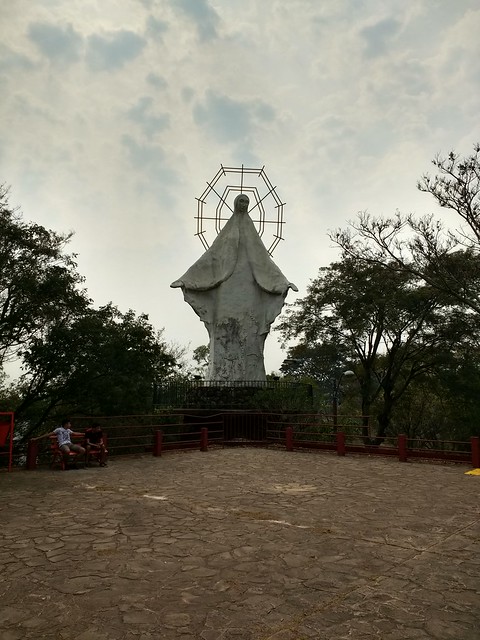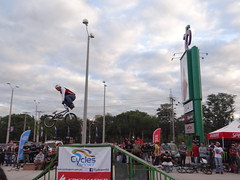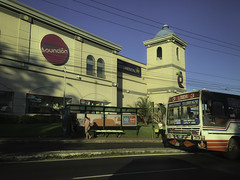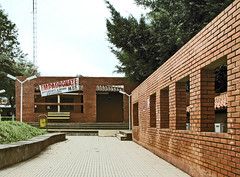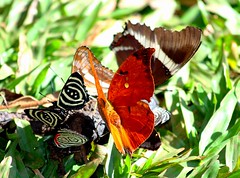 Paraguay
Paraguay
Paraguay (English: /ˈpəɡw/; Spanish: [paɾaˈɣwaj]), officially the Republic of Paraguay (Spanish: República del Paraguay Guaraní: Tavakuairetã Paraguái, is a landlocked country in South America. It is bordered by Argentina to the south and southwest, Brazil to the east and northeast, and Bolivia to the northwest. It has a population of 7,383,360 as of April 14th, 2023, and nearly 3 million of whom live in the capital and largest city of Asunción, and its surrounding metro. Although one of only two landlocked countries in South America (Bolivia is the other), Paraguay has ports on the Paraguay and Paraná rivers that give exit to the Atlantic Ocean, through the .
Spanish conquistadores arrived in 1524, and in 1537 established the city of Asunción, the first capital of the Governorate of the Río de la Plata. During the 17th century, Paraguay was the center of Jesuit missions, where the native Guaraní people were converted to Christianity and introduced to European culture. After the expulsion of the Jesuits from Spanish territories in 1767, Paraguay increasingly became a peripheral colony, with few urban centers and settlers. Following independence from Spain in the early 19th century, Paraguay was ruled by a series of authoritarian governments characterized by nationalist, isolationist and protectionist policies. This period ended with the disastrous Paraguayan War (1864–70), during which the country lost half its prewar population and around 25–33% of its territory to the Triple Alliance of Argentina, Brazil and Uruguay. In the 20th century, Paraguay faced another major international conflictthe Chaco War (1932–35) against Boliviain which it prevailed. Afterwards, the country came under a succession of military dictators, culminating in the 35-year regime of Alfredo Stroessner, which lasted until his overthrow in 1989 by an internal military coup. This marked the beginning of Paraguay's democratic era, which continues to this day.
Paraguay is a developing country, ranking 105th in the Human Development Index. It is a founding member of Mercosur, the United Nations, the Organization of American States, the Non-Aligned Movement and the Lima Group. Additionally, the city of Luque, in metropolitan Asuncion, is the seat of the South American Football Confederation.
The majority of Paraguay's seven million people are mestizo, and Guarani culture remains widely influential; more than 90% of the population speak various dialects of the Guarani language alongside Spanish. Paraguay is South America's poorest country and the second poorest South American nation in GDP/per capita. Despite a history of poverty and political repression, in a 2017 Positive Experience Index based on global polling data, Paraguay ranked as the "world's happiest place".
Etymology
The name Paraguay stems from Guarani paraguá "feather crown" and y "water" thus paraguaí "feather crown of waters".
History
Pre-Columbian era
The indigenous Guaraní had been living in eastern Paraguay for at least a millennium before the arrival of the Spanish. Western Paraguay, the Gran Chaco, was inhabited by nomads of whom the Guaycuru peoples were the most prominent. The Paraguay River was roughly the dividing line between the agricultural Guarani people to the east and the nomadic and semi-nomadic people to the west in the Gran Chaco. The Guarcuru nomads were known for their warrior traditions and were not fully pacified until the late 19th century. These indigenous tribes belonged to five distinct language families, which were the bases of their major divisions. Differing language speaking groups were generally competitive over resources and territories. They were further divided into tribes by speaking languages in branches of these families. Today 17 separate ethnolinguistic groups remain.
Colonization
The first Europeans in the area were Spanish explorers in 1516. The Spanish explorer Juan de Salazar de Espinosa founded the settlement of Asunción on 15 August 1537. The city eventually became the center of a Spanish colonial province of Paraguay.
An attempt to create an autonomous Christian Indian nation was undertaken by Jesuit missions and settlements in this part of South America in the eighteenth century. They developed Jesuit reductions to bring Guarani populations together at Spanish missions and protect them from virtual slavery by Spanish settlers and Portuguese slave raiders, the Bandeirantes, in addition to seeking their conversion to Christianity. Catholicism in Paraguay was influenced by the indigenous peoples; the syncretic religion has absorbed native elements. The reducciones flourished in eastern Paraguay for about 150 years, until the expulsion of the Jesuits by the Spanish Crown in 1767. The ruins of two 18th-century Jesuit Missions of La Santísima Trinidad de Paraná and Jesús de Tavarangue have been designated as World Heritage Sites by UNESCO.
In western Paraguay, Spanish settlement and Christianity were strongly resisted by the nomadic Guaycuru and other nomads from the 16th century onward. Most of these peoples were absorbed into the mestizo population in the 18th and 19th centuries.
Independence and rule of Francia
Paraguay overthrew the local Spanish administration on 14 May 1811. Paraguay's first dictator was José Gaspar Rodríguez de Francia who ruled Paraguay from 1814 until his death in 1840, with very little outside contact or influence. He intended to create a utopian society based on the French theorist Jean-Jacques Rousseau's ''Social Contract''. Rodríguez de Francia was nicknamed El Supremo.
Rodríguez de Francia established new laws that greatly reduced the powers of the Catholic church (Catholicism was then an established state religion) and the cabinet, forbade colonial citizens from marrying one another and allowed them to marry only blacks, mulattoes or natives, in order to break the power of colonial-era elites and to create a mixed-race or mestizo society. He cut off relations between Paraguay and the rest of South America. Because of Francia's restrictions of freedom, Fulgencio Yegros and several other Independence-era leaders in 1820 planned a coup d’état against Francia, who discovered the plot and had its leaders either executed or imprisoned for life.
Rule of the López family
After Francia's death in 1840, Paraguay was ruled by various military officers under a new junta, until Carlos Antonio López (allegedly Rodríguez de Francia's nephew) came to power in 1841. López modernized Paraguay and opened it to foreign commerce. He signed a non-aggression pact with Argentina and officially declared independence of Paraguay in 1842. After López's death in 1862, power was transferred to his eldest son, Francisco Solano López.
The regime of the López family was characterized by pervasive and rigid centralism in production and distribution. There was no distinction between the public and the private spheres, and the López family ruled the country as it would a large estate.
The government exerted control on all exports. The export of yerba mate and valuable wood products maintained the balance of trade between Paraguay and the outside world. The Paraguayan government was extremely protectionist, never accepted loans from abroad and levied high tariffs against imported foreign products. This protectionism made the society self-sufficient, and it also avoided the debt suffered by Argentina and Brazil. Slavery existed in Paraguay, although not in great numbers, until 1844, when it was legally abolished in the new constitution.
Francisco Solano López, the son of Carlos Antonio López, replaced his father as the President-Dictator in 1862, and generally continued the political policies of his father. Both wanted to give an international image of Paraguay as "democratic and republican", but in fact, the ruling family had almost total control of all public life in the country, including church and colleges.
Militarily, Carlos Antonio López modernized and expanded industry and the Paraguayan Army and greatly strengthened the strategic defenses of Paraguay by developing the Fortress of Humaitá. The government hired more than 200 foreign technicians, who installed telegraph lines and railroads to aid the expanding steel, textile, paper and ink, naval construction, weapons and gunpowder industries. The Ybycuí foundry, completed in 1850, manufactured cannons, mortars and bullets of all calibers. River warships were built in the shipyards of Asunción. Fortifications were built, especially along the Apa River and in Gran Chaco. The work was continued by his son Francisco Solano and in terms of socio-economic development, the country was dubbed as "the most advanced Republic in South America", notably by the British judge and politician Sir Robert Phillimore.
According to George Thompson, Lieutenant Colonel of Engineers in the Paraguayan Army prior to and during the war, López's government was comparatively a good one for Paraguay:
Paraguayan War (1864–1870)
On 12 October 1864, despite Paraguayan ultimatums, Brazil (allied with the Argentine Government under General Bartolomé Mitre and the rebellious Uruguayan colorados led by Gen. Venancio Flores) invaded the Republic of Uruguay in order to overthrow the government of that time (which was under the rule of the Blanco Party, an ally of López), thus starting the Paraguayan War.
The Paraguayans, led by the Marshal of the Republic Francisco Solano López, retaliated by attacking Mato Grosso on 15 December 1864 and later declared war against Argentina on 23 March 1865. The Blanco Government was toppled and replaced by a Colorado Government under General Venancio Flores on 22 February 1865. Afterward, the Argentine Republic, the Empire of Brazil and the Republic of Uruguay signed the Secret Treaty of the Triple Alliance against the Paraguayan Government on 1 May 1865.
The Paraguayans put up a ferocious resistance but ultimately lost in 1870 in the Battle of Cerro Corá, where Marshal Solano López refused to surrender and died in…
Looking for places related to Paraguay?
Those are other destinations to find places related to Paraguay:
